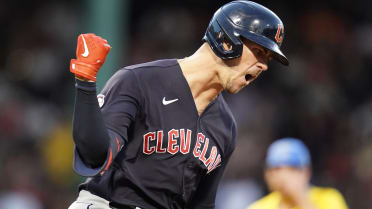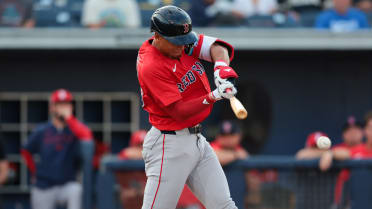Ballplayers have to be fearless and supremely confident in their abilities to succeed at the Major League level, but nothing can prepare them for "the yips."
The sport’s most dreaded mental malady has fallen upon all sorts of players, from fairly unknowns to superstars. Suddenly, an infielder can’t throw the ball to first base. A catcher can’t get the ball back to his pitcher. A pitcher can’t find the plate. After years of training and repetition, the yips can come from out of nowhere, as Astros star second baseman Jose Altuve (who didn’t make a throwing error across the 2020 regular season) is finding out with his suddenly untrustworthy right arm in this year’s American League Championship Series.
Altuve is far from the first player to deal with the yips, and he won’t be the last. Below is a comprehensive (if not complete) look at players who famously came down with the yips in years’ past. One thing to note: while the yips were part of their stories, many of these players went on to enjoy more success in the big leagues.
Pitchers
Jon Lester
Lester has shown impeccable command of the strike zone during his career, especially in postseason play, but his inability to throw the ball to first base was baseball’s worst-kept secret for many years. The southpaw simply couldn’t throw the ball accurately to anywhere besides home plate, to the point where he simply abandoned pickoff throws, bounced his fielding throws to first and even resorted to throwing his glove over there with the ball inside it.
Lester’s hesitance to throw over had serious implications in the 2014 AL Wild Card Game, when the Royals stole three bases against him and erased a four-run deficit in one of the most thrilling contests in recent memory. But Lester eventually turned his hang-up into an advantage after signing with the Cubs, altering his time between pitches so effectively to the point that (with the help of catchers David Ross and Willson Contreras) opposing teams basically stopped trying to run against him altogether. Lester has even caught baserunners with throws on the bounce in recent years.
Daniel Bard
Once the most prized pitching prospect in the Red Sox’s farm system, Bard went from one of MLB’s hardest-throwing relievers to being completely out of the Majors thanks to a nasty case of the yips. The righty compiled a 2.88 ERA and averaged nearly 10 strikeouts per nine innings from 2009-11, but the wheels came off in ‘12 when injuries, poorly-timed mechanical adjustments and performance anxiety caused Bard to completely lose the plate. Bard’s ERA ballooned to 6.27 as he averaged nearly seven walks per inning across 2012-13 before Boston placed him on waivers. Five different teams subsequently tried and failed to fix Bard’s accuracy issues, to the point where he tried to convert himself into a submarine pitcher.
“I’m trying to throw bowling balls,” Bard recalled to MLB.com’s Jon Paul Morosi. “I used to throw 100 [mph] over the top. Now I’m trying to trick people with topspin fastballs. It was tough. I’m not even trying to be the same thing I was before. I’m hanging on for dear life. Those were some trying days.”
But Bard’s story didn’t end there. He temporarily retired in 2017 and worked as a player mentor for the D-backs before embarking on a remarkable comeback in the summer of ‘20. Bard, throwing high-90s fastballs over the top again with ease at age 35, made the Rockies’ Major League roster following MLB’s hiatus due to the coronavirus pandemic and became the team’s best reliever, finishing the ‘20 campaign with a 3.65 ERA and 27 strikeouts to only 10 walks across 24 2/3 innings.
Matt Garza
One very bad throw for Garza in the spring of 2012 led to another and another for the Cubs right-hander, and it got to the point where opponents were seemingly bunting to the mound on purpose to see if he would throw it away again. On one particularly memorable day at Wrigley Field, Garza simply had to throw to first base to get the final out of a shutout, only to put a scare into the fans in the seats instead. (Garza was pulled from the game, but Chicago still got the shutout.)
"If you bunted on him, he's throwing it down the right-field line," outfielder Jason Tyner told MLB.com in 2013. "It wasn't even close. You'd see him over on a back field working on it and it'd look like a 6-year-old trying to throw to first base. He could throw 95 mph wherever he wants to the batter, but he could not throw the ball to first base."
Garza’s throwing yips continued to plague him for several years, but they didn’t keep him from being a steady innings-eater for the Brewers until his retirement following the 2017 season.
Rick Ankiel
Perhaps no pitcher is associated more with both the yips -- and a player’s ability to come back from them -- more than Ankiel. He was the Cardinals’ generational left-handed pitching prospect, and was thought of so highly in the St. Louis organization that manager Tony La Russa gave him the ball to start Game 1 of the 2000 NLDS against the Braves. That proved to be a turning point in Ankiel’s life, as he fired five wild pitches and walked six batters in a game that the Cardinals still won. Those miserable struggles continued against the Mets in the NLCS, where Ankiel walked five of the 10 batters he faced.
After more struggles to begin 2001, the Cardinals sent Ankiel down to Triple-A and eventually all the way down to Rookie-level ball. Injuries followed, and after a brief return to the Major League mound in 2004, Ankiel successfully converted to the outfield -- where his arm strength (and his powerful bat) shone. After retiring in ‘14, Ankiel wrote a celebrated memoir entitled “The Phenomenon: Pressure, The Yips, and the Pitch that Changed My Life.”
Mark Wohlers
Wohlers ranked among the most imposing and effective closers of the mid-1990s, saving 97 games for the Braves from 1995-97. But his effectiveness came to a screeching halt in ‘98, when he walked 33 batters and fired seven wild pitches in only 20 1/3 innings and saw his ERA skyrocket to 10.18. When Atlanta sent Wohlers down to Triple-A to try to fix his issues, he walked 37 more batters in just 13 1/3 innings. Wohlers went on to pitch in parts of five more seasons for the Braves, Reds, Yankees and Indians, eventually taming his wildness but never again finding that previous level of dominance -- thanks in part to elbow troubles that led to two Tommy John surgeries.
Steve Blass
Blass’ yips were so severe that his namesake -- the “Steve Blass Disease” -- became synonymous with the affliction. Blass had already been to the top of the mountain, recording a pair of 18-plus win seasons, winning each of his two starts (including Game 7) in the Pirates’ 1971 World Series triumph and earning an All-Star Game selection in ‘72.
But the yips don’t care about anyone’s resume. In 1973, Blass walked 84 batters across 88 2/3 innings and saw his ERA balloon to 9.85. The Pirates sent Blass down to the Minors, and his one shot at a return (eight runs allowed, seven walks in five innings) in ‘74 didn’t work out. Blass’ promising career was over even quicker than it had ascended, and he promptly retired and became a sales representative for a ring company. Blass later returned to the Pirates as a beloved broadcaster for more than three decades.
Position players
Jarrod Saltalamacchia
Saltalamacchia ranked among the Majors’ top catching prospects, but even that pedigree couldn’t save him from the yips. Beginning in 2010, “Salty” developed issues with the most basic task for a catcher: throwing the ball back to his pitcher after each delivery. The Rangers quickly sent Saltalamacchia down to the Minors, where he demolished Triple-A pitching but still couldn’t return to the bigs because of his throwing issue.
Saltalamacchia sought help from a sports psychologist and turned his career around after the Rangers traded him to the Red Sox. His finest season came with the 2013 World Series champion Sox, when he hit .273, smacked 40 doubles and 14 homers and drove in key runs during Boston’s march through October.
Chuck Knoblauch
Knoblauch was already an AL Rookie of the Year winner, a four-time All-Star, a World Series champion with the Minnesota Twins and -- most importantly for our purposes here -- a Gold Glove Award-winning second baseman when he was traded to the Yankees prior to the 1998 season.
But for some reason, after moving to the Bronx, Knoblauch found tons of trouble throwing the ball to first base. Knoblauch committed 26 errors during the 1999 campaign, and things only got worse by the time the Yankees played the White Sox in a three-game series in June 2000. Knoblauch committed three errors in just six innings in the series opener before taking himself out of the game, and two days later he fired a throw so errant that it hit broadcaster Keith Olbermann’s mother in the Yankee Stadium seats. The Yankees had to move Knoblauch to the outfield, but he did help the Bronx Bombers capture three straight World Series championships.
Mackey Sasser
Before Salty, there was Sasser. The former Mets catcher is one of the only men on this list who was never able to cure his case of the yips, at least while he was still a professional. Beginning in 1989, every Sasser throw back to the pitcher became an adventure. The hang-up was obvious; Sasser would receive a pitch and then seemingly stutter with his arm, pump-faking several times before he was able to release the ball back to the mound.
The problem forced the Mets to slowly shift Sasser to the outfield or first base. After logging a career-high 100 games for New York in 1990, Sasser never reached that total again across five more sporadic seasons with the Mets, Mariners and Pirates. Though he was out of baseball by the end of ‘95, Sasser eventually overcame the issue and became a successful coach in the collegiate ranks. Sasser has often reached out to other players afflicted with the yips, and has been a major advocate for therapy and sports psychology. It is also believed that Sasser’s throwing yips inspired the character Rube Baker in the film “Major League 2.”
Steve Sax
Sax, like Knoblauch, was a Rookie of the Year Award winner, World Series champion and accomplished second baseman when he suddenly forgot how to throw the ball to first base. The problem first cropped up in 1983, when Sax inexplicably committed 30 errors for the Dodgers and released throws so wide that fans down the first-base line began wearing batting helmets for “protection.”
Sax continued to struggle over the next few seasons, earning himself the “Steve Sax Syndrome” moniker as the fielder’s version of Blass’ “disease,” but his story is ultimately one of success. Sax cured his throwing issues and helped lead the Dodgers to another World Series championship in 1988, and he led all AL second baseman in fielding percentage the following year after signing with the Yankees.
Dale Murphy
Diehard fans of Murphy will recall that the two-time NL MVP Award-winning outfielder actually came up the Braves’ ranks as a catcher. That’s not to say that he played the position well, however; Murphy committed 17 errors and allowed 31 passed balls across just 85 big league games behind the plate from 1976-79. Murphy’s throws to second base would bounce in front of the pitcher’s mound or sail into the outfield or go in any other direction instead of the intended target.
“It’ll come around,” said Murphy in 1977, after he was demoted to the Minors to fix his throwing issues. “It’s got to be in my head and not physical. It’s been discouraging but something I’ve got to forget.”
It never did come around, but this case of the yips actually worked out well. Murphy flourished once he was moved to first base and then the outfield, becoming one of the biggest stars of the 1980s with Atlanta.
Matt Kelly is a reporter for MLB.com based in New York.




